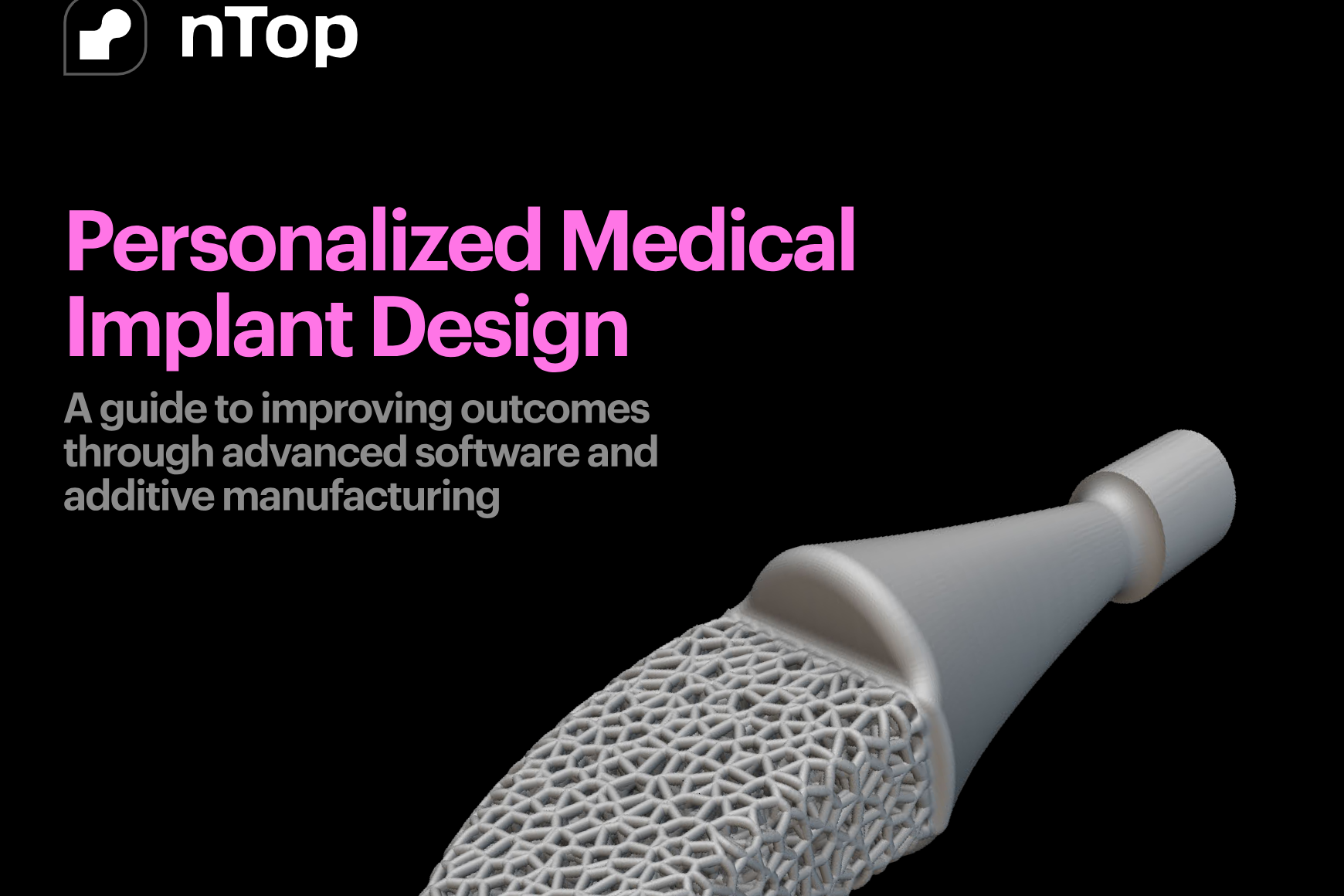Tangible Solutions | Designing lattice structures for medical implants
Written by Matt Shomper | Additive Medical Engineering Director, Tangible Solutions
Published on July 25, 2019
Software solutions like nTop enable engineers to design medical implants that are biologically-relevant and optimized for osseointegration.
In the orthopedic implant community, there are plenty of companies touting the benefits of their technologies, claiming these will facilitate bone ingrowth (or lead to the possibility of bone growth). Oftentimes – but not always – there is little clinical evidence to back up these claims other than commonly-repeated facts such as titanium promotes an environment for bone to grow. This is especially common in the case of plasma-spray titanium surfaces or acid-etched surfaces with no substrate porosity. While these may yield surfaces for initial expulsion resistance (preventing the cage from moving after implantation) and provide surfaces for bone to grow onto, they do little to yield long-term ingrowth to provide the best fixation and long-term results.
Many studies have been done to evaluate what constitutes a good porous structure. The stated “ideal” microstructure of bone tissue engineering construct was first defined in the 1990s when ceramic-based bone substitutes were evaluated. At the time it was established that an ideal pore size was somewhere between 0.30 mm and 0.50 mm. It also established that pore sizes below 0.100 mm did not provide the necessary ingrowth space for proper osseo- and angio-conductivity (Galois L, Mainard D. Bone ingrowth into two porous ceramics with different pore sizes: An experimental study. Acta Orthop Belg 2004;70:598–603). Further refinement of what constituted good lattices with parameterization experiments would continue to be done – culminating in a recent study which challenged some of the long-held beliefs on pore and strut size (Wild M et al. Osteoconductive Lattice Microarchitecture for Optimized Bone Regeneration. 3D Printing and Additive Manufacturing, Vol. 6, No. 1, 2019.) finding that optimal pore size trended closer to 0.80 mm.
And even though research has led the industry towards adoption of a common pore and strut size, further challenges remain and still need to be studied in-depth:
- Surface morphology of lattice structures – macro and micro topography
- Lattice type and shape manipulation for optimal initial attachment and long-term proliferation
- Correlation between optimal pore/strut sizes and macro stiffness of structures – preventing stress-shielding and adjacent biological issues
- Manipulation of mechanical properties via computational methods (functional lattice grading, topology optimization, etc.)
These kinds of problems create challenges for many software tools to build the kinds of structures that will lead to the next generation of orthopedic implants. Furthermore, with SLM (selective laser melting) machines becoming more advanced, manufacturing of these complex structures is becoming more and more of a reality – with machines now capable of resolving strut sizes under 0.100 mm (0.004”) and features as small as 0.080 mm (0.003”).
nTop is the next generation software that is helping solve these engineering challenges, providing powerful tools that allow for advanced lattice-feature manipulation. Functionally grading lattice structures is a challenging problem, but using various capabilities in nTop allows the design engineer to take TPMS lattices and grade them to any ramped structure.

A 20 mm cube with non-variable, 10 mm Gyroid TPMS cells.

The same 20 mm cube with functionally-graded Gyroid TPMS cells modified about 2 axes (X and Y). Note that the periodicity in the X and Y directions varies throughout the length.
This functionality doesn’t just stop at linear remapping – in fact, any geometry representation can be altered in each axis with any complex parametric equation.

The same 20 mm cube with modified Gyroid TPMS cells, where the X-axis has been mapped with an X² function.
This also isn’t just limited to remapping via axes only. Complicated models can be generated via parameters or topology optimization and used to functionally grade structures seamlessly, no matter the complexity. See images below that illustrate this capability:

The first input is a regularly-repeating volumetric lattice.

The second input is a stochastically generated Voronoi lattice at strut diameter ‘D’.
Using the above inputs, the volume lattice can be thickened seamlessly with the Voronoi lattice input. The amount of thickening can be controlled precisely, given parameterization. In this case, where the Voronoi lattice material exists, the final lattice thickness will be greater. The same principles can be applied when setting up the volume lattice to begin with – the cellular point spacing can be ramped via any representation that can be conceived and applied.

Selectively-graded volume lattice using Voronoi lattice input as ramp feature.
Using nTop’s capabilities, complex lattices can also be transformed seamlessly from one to another with no definable transition point. This results in structures that may not suffer from a single weak “shear” point. This type of structural generation between two entirely different macro features is a computational challenge that is just now being realized. And as mentioned before, the tools to produce such structures already exist. Having the freedom to not only achieve the strut and pore size that produces biological benefits but also maneuver the very structural elements, allows for complex manipulation of true orthotropic properties. This further helps engineers evaluate how bone ingrowth will change the macro stiffness of the construct and how to create lattice elements that provide long-term benefit when it comes to biological optimization.

Mixed TPMS structures, Lidinoid (L) to Gyroid (R) with different cell sizes.
As before, the manipulation of the mixed elements is not bound to a linear input. Objects can be mixed using complex structures or primitive models. See the below image where the same two TPMS lattices are mixed using an oblate spheroid (sphere stretched in the horizontal). Where the sphere exists, the cells are a Gyroid TPMS structure, and the design moves from the sphere transitions to a Lidinoid cellular structure with no obvious transition point.

Final TPMS Mixed Lattice, with the location of a sphere controlling the gradual transition zone.
These tools can be used to transition complex lattice shapes to external solid features, simulating biological mimicry of bony structure (cortical and trabecular elements), and the seamless organic transition between them. This type of control over the internal and external structures, as well as discrete control of the transitioning elements, can help give implant developers the ability to alter structural properties on a macro and micro level. It also helps them understand how structures alter as bone integrates into them -- as well as engineer implants with specific ingrowth factors.

Section view of a simulated vertebral body segment showing nTop’s ability to mimic the morphology of bone and its seamless transition from trabecular to cortical features
This can be further refined by setting up transition phases from one structural element to another, as shown below in purple -- to define continuous mechanical properties from entirely different structural types.

Example structure showing the transition between a solid element and an internal latticed structure.
The examples shown here are only a small subset of the available tools that nTop provides for the design and building of biologically-relevant structures.
Summary
In this short post, we’ve explored some history of studies concerned with what makes a good biological structure – including analysis of pore and strut size. We’ve also looked at some limitations facing engineers as they try to architect the next generation of advanced structures – and how nTop is providing these tools. Placing these types of tools in the hands of advanced-modeling professionals will further help facilitate implants that have been purposefully and thoughtfully designed to achieve results once never thought achievable.

Matt Shomper
Additive Medical Engineering Director, Tangible Solutions
Matt is an innovative engineering leader with a strong interest in next-gen and upcoming technologies and is keeping on the forefront of additive and materials advancement in his field. He is currently building and leading a world-class, highly technical engineering department in the additive manufacturing space. With many cleared medical devices released into the field now residing in numerous patients worldwide, Matt has proficient skill in developing solutions quickly and effectively to provide the most cost-effective solution in the shortest amount of time.
Related content
- CASE STUDY
Replacing spacecraft supermaterial with high-performance lattice

- VIDEO
Design better implants for osseointegration with the Lattice Pore Size Block

- VIDEO
nTop CDS 2024: Exploring the cutting edge of computational design with Matthew Shomper

- CASE STUDY
Cobra Golf designed their LIMIT3D irons 50% faster with nTop

- GUIDE
Download: Advanced design software and additive manufacturing for personalized implants
